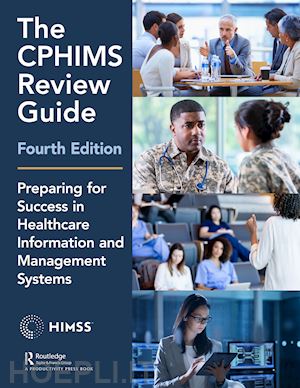Contents Acknowledgments Preface Editor SECTION I GENERAL 1 The Healthcare Environment Learning Objectives Introduction Healthcare Organizations Hospitals Outpatient or Ambulatory Care Community Health Organizations Diagnostic and Pharmaceutical Services Healthcare Payers Interrelations within and across Healthcare Organizations Enabling Access to Comprehensive Care Services Assuring Effective Transfers of Care Ensuring the General Portability of Care Reporting Public and Population Health Information Obtaining Appropriate Reimbursement for Quality Care Supporting Particular Organizational Models of Care Roles and Responsibilities of Healthcare Information and Management Systems Professions Roles of Government, Regulatory, Professional, and Accreditation Agencies in Healthcare Government Healthcare Regulators Professional Associations Accreditation Organizations Summary References 2 The Technology Environment … Learning Objectives … Introduction … Hardware in Healthcare IT … Technology Infrastructure Servers Data Storage Mobile Devices Medical Devices Networks in Healthcare IT Network Infrastructure Communications Software in Healthcare IT Clinical Applications Administrative Applications Financial Applications Consumer Applications Key Trends and Issues in Healthcare Technologies Health Information Exchanges Interoperability and Standards Data Integration Data Warehouses Clinical and Business Intelligence (CBI) Telehealth and Telemedicine Privacy and Security Conclusion References SECTION II SYSTEMS 3 Systems Analysis Learning Objectives Introduction Healthcare Problems and Opportunities for IT Implementation Clinical Functions Applications for Clinical Functions Administrative and Financial Services Applications for Administration and Finance Infrastructure Security-Related Applications Needs Analysis in Healthcare Facilities Operational Needs Staff Productivity and Satisfaction Increased Revenue and Cost Optimization Patient Safety Quality of Care Patient Access to Services Needs Summary Needs Prioritization Work Plan Development Executive Summary Introduction and Background Goals and Objectives Resources Work Plan Accountability Current Clinical Processes Current Healthcare IT Integration Status Deficiencies in Current IT Healthcare Practices Patient Support and Satisfaction Reduction in Revenue Generation Prescription Errors Industry Standardization Alternative Approaches to Current Healthcare Processes Industry Standardization Alternative Ways to Reduce Prescription Errors Alternative Processes for Revenue Generation Comparative Analysis of Alternatives Proposal Evaluation Cost–Benefit Analysis Proposal Sensitivity Analysis References 4 Systems Design Learning Objectives Introduction Business Process Management Compatibility of System Components Standards Compliance Process to Address Industry Trends Structure of the System Design Team Detailed Technical Specifications Usability Business Process Reengineering Information Infrastructure Data Management Creating a Request for Information (RFI) Making a Buy versus Build Decision Process for a Build Decision Buy Decision: Best-of-Breed versus Single-Vendor Solution Creating a Request for Proposal (RFP) Summary References 5 Systems Selection, Implementation, Support, and Maintenance Learning Objectives Introduction Solution Selection Criteria Selecting Review Team Members Solution Selection Activities Implementation Process Organizational Change Management Implementation Strategies Implementing Solutions System Integration to Support Business Requirements User and Operational Manuals and Training Activation Planning and Immediate Postactivaton Activities Managing Healthcare Information Systems Analyzing Data for Problems and Trends Ensuring Critical Functions Are Repaired, Maintained, or Enhanced Business Continuity and Disaster Recovery Plans Bibliography 6 Systems Testing and Evaluation Learning Objectives Introduction Purpose of Systems Testing Test Methodology Test Strategy Test Tools Test Execution Test Controls Test Reporting Final Evaluation References 7 Systems Privacy and Security Learning Objectives Introduction Defining Requirements, Policies, and Procedures Risk Assessment Vulnerability Remediation User Access Controls Confidentiality, Integrity, and Availability Organizational Roles Data Management Controls Disaster Recovery and Business Continuity Plans Auditing Ongoing System Evaluation References SECTION III ADMINISTRATION 8 Administration Leadership Learning Objectives Introduction 8Participation in Organizational Strategic Planning Mission Vision Values Goals Organizational Environment Forecasting Technical and Information Needs of an Organization Developing the IT Strategic Plan Implementing the IT Strategic Plan Evaluating Performance Evaluating Effectiveness and User Satisfaction Promoting Stakeholder Understanding of IT Opportunities and Constraints Developing Policies and Procedures for Information and Systems Management Complying with Legal and Regulatory Standards Adhering to Ethical Business Principles Employing Comparative Analysis Strategies Budgets Other Financial and Nonfinancial Indicators Benchmarks Quality Indicators Preparing and Delivering Business Communications Facilitating Group Discussions and Meetings Providing In-House Consulting Services Developing Educational Strategies for IT Staff Staying Current on IT Technologies and Trends Managing Risk Quality Standards and Practices ……………………………………………………. References …………………………………………………………………………... 9 Administration Management .. Learning Objectives Introduction …………………………………………………………………………. Roles and Responsibilities for IT-Related Functions ……………………………… Senior Management Roles and Responsibilities ………………………………. General IT Roles and Responsibilities ………………………………………… Healthcare IT Roles and Responsibilities ……………………………………… Careers in Healthcare IT…………………………………………………………. Achieving Staff Competency in Information and Management System Skills ……………………………….……………………………….………………… Employee Development ……………………………….………………………… Organizational Training and In-Service Programs ……………………………… Job-Related IT Certifications ……………………………………………………. Miscellaneous Professional Development ………………………………………. Performance Evaluation ……………………………….………………………… Managing Projects and Project Portfolios ……………………………….……………. Managing Vendor Relationships ……………………………….……………………... Facilitating Steering Committee Meetings ……………………………….…………… Adhering to Industry Best Practices ……………………………….………………….. Developing System, Operational, and Department Documentation ………………….. System Documentation ……………………………….………………………….. Operational Documentation ……………………………….……………………... Department Documentation ……………………………….……………………… Providing Customer Service ……………………………….………………………….. Service-Level Management ……………………………….……………………… Request Tracking ……………………………….………………………………… Problem Resolution ……………………………….………………………………. Managing Budget and Financial Risks ……………………………….………………... Financial Risk Management ……………………………….…………………………… Budget Risk Management ……………………………….……………………………… Managing Customer Relationships with Business Leaders …………………………….. Summary ……………………………….……………………………….………………. References………………….……………………………….…………………………. 10 Questions … Chapter 1: The Healthcare Environment ………………………………………… Chapter 2: The Technology Environment ………………………………………. Chapter 3: Systems Analysis ……………………………….…………………… Chapter 4: Systems Design ……………………………….……………………… Chapter 5: Systems Selection, Implementation, Support, and Maintenance ........... Chapter 6: Systems Testing and Evaluation ……………………………………… Chapter 7: Systems Privacy and Security ………………………………………… Chapter 8: Administration Leadership ……………………………….…………… Chapter 9: Administration Management …………………………………………. 11 Answer Key … Chapter 1: The Healthcare Environment … Chapter 2: The Technology Environment … Chapter 3: Systems Analysis … Chapter 4: Systems Design …. Chapter 5: Systems Selection, Implementation, Support, and Maintenance ........











